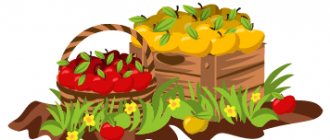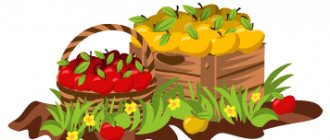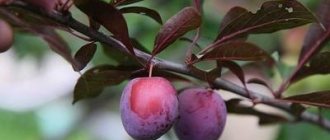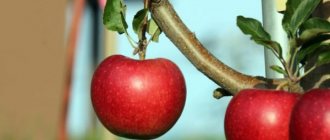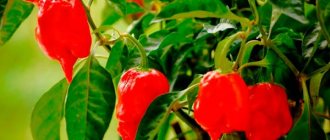Description of the Niedzwiecki apple tree
This medium-sized crop grows no more than 5 m, the wild one grows up to 8 m. The crown of an adult plant takes on a spherical shape. The bark, leaves and shoots are dark purple. The tree trunk is powerful, wide, and prone to cracking. The branches are smooth, there are no thorns. During the flowering period, the leaves turn green, only the lower part remains purple. The leaf is narrow and oblong with serrations.
The flowers of the apple tree are medium in size (up to 4 cm in diameter), collected in buds, bright pink in color. The flowering period is short - no more than 10 days. Blooming flowers and the ovaries of new buds have a pink color of varying degrees of intensity.
The crop bears fruit in late September or early October. The fruiting period can last 30 days or more. The fruits are round or slightly oblong, red. Not only the skin, but also the flesh has an intense color. The surface of the apple is covered with a waxy coating. A description of the Niedzwiecki apple tree would not be complete without photos and reviews, which can be found at the end of the article.
Important! The root system of the apple tree is well developed, but it is superficial and needs insulation in winter.
How to propagate an apple tree
Now let's talk about the Niedzwiecki apple tree and its propagation. You can get a new tree in the traditional way - buy a seedling, or grow it yourself from seeds.
The process is, of course, long, but interesting. Fresh seeds from the Niedzwiecki apple tree do not sprout; they will have to be stimulated. To do this, stratification is carried out: for 3 or 4 months the seeds must lie at a temperature of three degrees.
Place the seed on a damp cloth in the refrigerator in the vegetable drawer. When stratification is complete, we sow the seeds in fertile soil for germination. We water the sprouts of the decorative apple tree and keep them in a warm room on a sunny window.
As the weather warms up, we plant them outside for growing. They are transplanted to a permanent place the next year. The principle of planting the Niedzwiecki apple tree is no different from the traditional one. Only the hole needs to be made large so as not to oppress the root system.
Niedzvetsky apple tree in landscape design
In the harsh northern climate, the Niedzwiecki apple tree successfully replaces the whimsical and heat-loving sakura. These crops are similar in appearance and color of flowers. The subtle, intoxicating aroma of the buds during flowering is an excellent addition to the spectacular appearance. The Niedzwiecki apple tree is planted surrounded by fruit trees that bloom in white: cherry, plum, apricot.
Surrounded by monotonously green pine needles, this crop looks especially bright. Apple trees are used in compositions with decorative evergreen crops. It is placed at the entrance to the garden, near a decorative path, or on the sides of an arch.
Elastic shoots and branches lend themselves well to decorative pruning. Gardeners give the spreading crown of a tree a variety of shapes. A tree crown trimmed in a special way looks good surrounded by ornamental shrubs.
Japanese-style gardens are the ideal backdrop for the Niedzwiecki apple tree. The close location of decorative ponds or fountains will be an excellent addition to the oriental composition. In the photo you can see how the decorative Nedzvetsky apple tree is used in landscape design.
Reviews from gardeners
Irina, 29 years old, Belgorod
My apple tree fits perfectly into the landscape of our dacha against the backdrop of an alpine hill. It looks very decorative due to its long-term abundant flowering with charming bright pink flowers with raspberry-purple edges. The plant is not capricious, mandatory pruning is limited to removing dry and damaged branches, everything else is determined by the general style of the garden and the desired shape of the crown. For me personally, the only way to escape from the bustle of the city is to look at this miracle tree and enjoy its intoxicating aroma.
Alina, 42 years old, Volokolamsk
The idea of growing a decorative apple tree from seeds purchased in an online store failed miserably. Last fall I even dug a planting hole for the future “beauty”. I sowed according to all the rules, but when it came time to care for the first shoots, the first shoots that appeared briefly turned black and withered. I don’t know what the reason is: either the soil was not suitable or the seeds were of poor quality.
Andrey, 46 years old, Moscow region
Ornamental apple trees are much easier to grow than fruit trees. They are undemanding to soils, even in depleted soils they look attractive, but they grow more slowly. They do not need to create a skeletal crown, it is quite possible to do without pruning at all, but even after frequent and heavy pruning they recover well and keep their shape.
Pros and cons of the Niedzvetsky apple tree variety
Among the advantages of the variety are resistance to common apple pests and diseases and rapid growth. This culture easily takes root in any area, in difficult climatic conditions, and is undemanding to care. The plant can be propagated by seeds. The main advantage of the variety is its frost resistance and drought resistance.
Disadvantages include a tendency to be affected by scab and aphids. The root system requires insulation for the winter. After planting, a seedling can take root for a long time and become sick.
Subspecies and options
Niedzvetsky can be grown in several varieties and variants. Thanks to vaccinations, they acquire certain properties. The photo demonstrates different types of cultivation of this ornamental variety.
On the standard
Most often, in the wild, this ornamental variety is grown as a tall tree. But various scions can be grafted onto the trunk to decorate a park or garden.
Apple tree on a trunk.
Royalty
The decorative subspecies of Niedzwiecki is most similar to sakura. Its growth is low, usually up to 4 meters, the crown is dense and very leafy. The buds look very presentable even when not opened, and when they bloom, they are completely amazing.
The crown is rounded, covered with large leaves of a purple hue. The apples are small, dark red, but completely inedible.
Redleaf
The ornamental variety of the Niedzvetsky variety is grown mostly as a spreading red-leaved shrub. Its crown is drooping, green in a purple hue with a glossy sheen. The flowers emit an amazing aroma; they are small and light pink. The fruits are very small, like rowan berries, yellow-red in color.
Weeping
A subspecies of ornamental apple tree, also called Prirechnaya. The variety looks like a tall fruit crop with a drooping crown. This species can be grown near water bodies. It is unpretentious and resistant to unfavorable climatic conditions.
wild
The apple tree was originally found in the Tien Shan mountains. The area of origin is rather dubious. Therefore, it can be grown even in unfavorable conditions, but loves good lighting.
Optimal growing conditions
This variety of apple tree grows in dry, well-lit areas with fertile soil. A young tree should be planted in the spring before the onset of heat or in the fall before the onset of cold weather. After planting, the seedling is shaded to avoid sunburn. Young trees no older than 2 years are rooted. It is difficult for older seedlings to take root in a new place.
The proximity of groundwater should be avoided. The soil must be loosened regularly before and after planting. It is important to feed the tree with organic and mineral fertilizers and water it on time.
Important! Loosening the soil and weeding is carried out carefully so as not to damage the root of the plant.
Growing in different regions
The characteristics of the tree are influenced by climatic and agrotechnical conditions.
In outskirts of Moscow
A couple of stones are buried next to the roots - they allow you to shift the flowering time by a couple of weeks. Otherwise, returning cold will kill the buds.
In the Leningrad region
You need to choose a sunny place for planting, but not in a lowland. Otherwise, apple trees adapt well to the conditions.
In Ukraine
Almost ideal conditions for the Niedzwiecki variety. Mild winters with no severe cold. The trees will grow quickly.
Important! To stimulate flowering, early pruning of the crown is carried out.
In Siberia and the Urals
In a windless place, trees tolerate frosts more easily. The “Siberian” variety of apple trees can be used as a graft. It will increase resistance to cold weather.
Planting and caring for an apple tree
This culture does not require special care. Good lighting and regular watering are the basic rules. A well-chosen planting site guarantees high survival rate and rapid growth of seedlings.
Selection and preparation of a landing site
To root a young Nedzvetsky seedling, open, well-lit areas are chosen. It is important to consider that the plant does not tolerate strong winds or drafts.
Before planting, you should thoroughly check the soil for the presence of groundwater. Their close occurrence, less than 3 m from the surface, can threaten the roots of the apple tree with rotting.
Tall plants or buildings should not be located near the seedling, so as not to shade the tree. The distance from other plants should not be less than 5 m.
Seedling preparation
The rhizome of a young plant is carefully examined, dry, rotten, damaged shoots are identified. They need to be cut off. Shoots that are too long are shortened.
The trunk is wiped with a damp cloth; it is necessary to find the place where the root collar is located. This is the transition from the green part of the plant to the woody brown part.
Before planting, it is good to soak the plant root for about an hour in a solution of mullein with water, ratio 2:5, or in a growth stimulator, “Kornevin”.
Planting the Niedzwiecki apple tree
Before planting, dig a hole 0.5 m wider than the size of the rhizome and 0.5 m deeper than the distance from the root to the root collar. Drainage material in the form of pebbles or expanded clay is placed at the bottom. A mound of equal parts mixture of soil and compost is poured on top of the stones.
A seedling is lowered into the hole, the roots are laid so that they are evenly distributed on a heap of fertilizer. A strong peg is driven in next to the trunk, which will serve as a support for the tree.
Having positioned the seedling in this way, they begin to cover the roots from the edges with loosened garden soil. The root collar of the plant should be located 1 cm above the soil level. The earth is carefully trampled down without damaging the rhizome.
A small mound of earth is placed around the trunk to prevent subsidence of the soil after watering. To moisten the rhizomes of a young Niedzwiecki apple tree, 1 bucket of water is enough. A day later, the tree trunk circle is mulched with sawdust or peat.
Important! The thin trunk must be secured by tying it to a dug-in support.
Watering and fertilizing
The apple tree is watered in the spring during the period of flowering and fruit formation. If it rains regularly, the plant does not need watering. In hot weather, watering with ice water is prohibited.
In summer, the tree is watered once a month in rainy weather and 2-3 times in dry weather. As soon as all the moisture has been absorbed, the soil is sprinkled with grass or peat. A day after watering, the soil is loosened. This procedure is carried out after each moistening of the soil.
The Niedzwiecki apple tree is fertilized 3 times a year:
- in the spring, as soon as warm weather settles and winter frosts disappear;
- in summer during the period of fruit formation;
- in the fall after harvesting in preparation for wintering.
Feed the plant during watering with mineral or organic fertilizers diluted in warm water. For spraying, you can take a solution of wood ash.
Trimming
A one-year-old seedling is not pruned. Shorten shoots of plants older than 2 years. This procedure stimulates the growth of side shoots and the expansion of the tree crown.
Preventative pruning is done in autumn and spring. During this process, dry and damaged branches are removed.
After 3 years, decorative pruning of the tree is carried out. Since the crown diameter of the Niedzwiecki apple tree can exceed 10 m, this procedure should become regular. It can be done in early spring. During this procedure, the branches are shortened by 2/3 of their length to form a lush, spreading crown. The cut areas are treated with garden varnish. To ensure that the crown has high decorative qualities, pruning is carried out every year.
Preparing for winter
The Niedzwiecki apple tree is frost-resistant, but in the northern regions it needs to be insulated in winter. It is especially important to cover the roots of the plant before frost sets in. This is done using an earthen embankment and dry fallen leaves, spruce trees, and peat.
The tree trunk is wrapped in fabric, peat, agrofibre, and wrapped with film on top. A mesh fence is built around the tree to protect the plant from pests and rodents. In the spring, at the first thaw, the warm layer is removed to avoid rotting of the shoots and rhizomes.
Landing
Pepin saffron apple tree: description of the variety
Apple trees can be planted in spring or autumn. If this is done after winter, then before the beginning of the growing season. The rest of the time - a month before the start of cold weather.
Soil preparation
Trees can be planted in any soil. It is desirable that the soil is fertile and moist. You can mix the soil with humus and organic fertilizer. The mixture is allowed to brew and brew.
Technology
For planting, dig a hole 1 meter deep and no more than 80 cm wide. Drainage is placed at the bottom, then peat and humus are poured in, and a little organic fertilizer can be added. A tree is placed on top and covered with soil.
Disembarkation in groups
When creating hedges or rows, you need to maintain a distance of 5 meters.
in autumn
In autumn, planting is done in the standard way. You can cover the tree trunk circle with foliage - a layer of at least 40 cm. This will protect the roots from frost.
Reproduction of the Niedzwiecki apple tree
This variety can be propagated by seeds. This is done using seeds obtained from the ripe fruits of the plant. They are dried and then hardened: the seeds are wrapped in a damp cloth and left on the bottom shelf of the refrigerator for a month and a half. After this, the seeds will have high germination rates, and the seedlings will be strong and resistant to the main types of diseases of garden plants.
After hardening, the seeds are soaked in a solution of a growth stimulator for half an hour and sown in closed, loose soil. As soon as the seedlings sprout, water them regularly and loosen the soil around them.
In the spring, when stable heat sets in, seedlings are rooted in open ground. Plants require regular watering and shading in the first month after planting. For the first 2-3 years, the seedling will practically not grow. After this time, the young apple tree will show good growth, at least 15 cm per year.
You can propagate an ornamental apple tree by grafting onto a fruit tree. At the same time, the survival rate of the scion is high.
The Niedzwiecki apple tree is often propagated by cuttings. To do this, choose a strong, healthy branch and cut it. Afterwards, the shoot is divided into several parts, approximately 15 cm each. One end of the cutting is soaked in the Kornevin solution for about an hour. Afterwards, the shoot is placed in warm water and waits for roots to appear. As soon as the root system is formed, the seedling is rooted into the ground. In spring, the plant can be transplanted to an open area.
Important! The survival rate of cuttings in open ground is low - 50%.
Features of ripening and fruiting
If the apple tree does not bloom, perhaps the problem is at a young age (up to 5 years the tree is just developing) or in nitrogenous soil. The tree may freeze - this happens if the planting site is chosen incorrectly. The crop may not bloom even if damaged by rodents.
Use of fruits
Apples can be dried and used in compotes. Fresh fruits are suitable for making jam, marshmallows, and cider. Kvass is also prepared from them.
Reproduction
The variety is propagated by cuttings, but then you need to take into account that splitting occurs according to characteristics. It is better to use cuttings. They are planted in the ground or grafted onto wild plants. Reproduction by root shoots is allowed.
Diseases and pests
The culture is resistant to garden pests and diseases. In the spring, to prevent the reproduction of insects under the tree bark, the trunk must be treated with lime. The root shoots are cut off to remove the larvae of garden pests.
Spring pruning of the crown of an apple tree will avoid the spread of fungal diseases and will be a good prevention of the proliferation of harmful insects.
Important! Despite the variety's resistance to diseases, in the spring they are sprayed with insecticides and fungicides for preventive purposes.
Scab is a common disease of apple trees of this variety. In autumn, fallen leaves are burned; they are a source of damage. The wood is treated with ammonium nitrate solution. To prevent the disease, the soil around the trunk is regularly dug up to avoid high humidity.
History of selection
The Niedzwiecki apple tree is an ornamental tree, but due to its resistance it can be grown almost everywhere and is not afraid of frost. The variety is most widespread in North America and Europe, despite its eastern origin.
Did you know? There is an apple tree in the world that is currently 372 years old. It was planted in 1647 in the USA, in one of the private gardens in Manhattan.
The tree is named after the botanist V. E. Nedzvetsky, who first discovered this wild plant while traveling in the Chinese province of Xinjuang. The sample of shrub brought by Nedzvetsky was handed over in 1891 to the German biologist Georg Dick, who is responsible for the further study and selection of the modern variety.
Reviews of the Niedzwiecki apple tree
Sushko Irina Nikolaevna, 45 years old, Novoshakhtinsk
In spring, beautiful ornamental trees bloom in scarlet along the alleys of our city. For some reason, I was sure that these were sakura, the fruits of the tree are small like cherries. A friend advised me to take a closer look at these “berries”; in fact, it turned out that they were apples. Now I want to have this beauty (red-leaved Niedzwiecki apple tree) in my garden. I think I will find a decent seedling by spring.
Karpov Vladislav Olegovich, 35 years old, Irpen
For a long time, my grandmother had an apple tree with a beautiful bright red color growing in her garden. I never thought about what kind of crop this was, and I didn’t particularly like its fruits. But the spring flowering of this tree will not leave anyone indifferent, especially the aroma. Later I learned that this is a weeping apple tree of Niedzwiecki, and now I am proud of this rare and beautiful plant.
Malakhova Vera Petrovna, 56 years old, Minsk
I often hear negative reviews about the taste of the fruits of the ornamental Niedzwiecki apple tree. I'll tell you straight: people just don't know how to cook them. I always have compotes with the tart, sweet and sour flavor of these small apples. I like that you can load them whole into a jar. Would you know how tasty and beautiful the compotes are!
Harvest and storage
The fruits on the Niedzwiecki apple tree reach full maturity in late September - early October. During this period they can be removed from the branches. A distinctive feature of this variety is that the fruits do not fall to the ground after ripening and can remain on the branches all winter.
There is an opinion that apples that have survived frost have a better taste. After harvesting, the fruits are either dried for further storage or sent for processing: preparation of compotes, jams and other types of preservation.
So, having familiarized yourself with the characteristics of the unusual and very beautiful Nedzvetsky apple tree, it can be noted that this plant rightfully occupies an honorable place among the most popular examples of landscape design. Its stability and unpretentiousness combined with stunning flowering will not leave any gardener indifferent.
Characteristics of the variety
The peculiarity of the Niedzwiecki apple tree is purple leaves, branches with a burgundy tint and red pulp of the fruit. These characteristics are provided to the variety by the anthocyanin pigment present in all parts of the plant. Moreover, the concentration of purple natural dye is high all year round.
The wild red apple tree was discovered in northern China in the foothills of the Tien Shan at the beginning of the 20th century. The culture received its name from the discoverer V.I. Nedzvetsky, who became interested in the unusual, bright apple tree, collected its fruits and gave it to scientists for propagation and study.
Later, the culture became a rich basis for selection. Michurin actively used Nedzvetsky's apple tree in his work. Based on the wild plant, many varieties of red-fleshed apples have been created.
Famous varieties are descendants of the Niedzwiecki apple tree:
- Komsomolets;
- Pioneer;
- Yakhontovoye;
- Red Standard;
- Pepin crimson;
- several varieties of the Bas-relief variety.
Moreover, the first two varieties are recommended for cultivation in risky farming areas, in particular in the north-west of the country. Most of the selected species have adopted high winter hardiness from the mother variety and have large, beautiful crimson-colored flowers. The differences between them are the height of the trees and the shape of the apples.
The Nedzvetsky apple tree received a description, photo and recommendations for cultivation thanks to the efforts of breeders and amateurs. The culture was never included in the State Register. Despite the lack of registration, the variety and its cultivars are invariably popular among gardeners and in demand in landscape design.
Description of the tree
Young trunks and growth of the Niedzwiecki apple tree are distinguished by a purple tint of the bark. Annual shoots are dark purple. With age, the color changes to gray with a brown tint. The trunk of an adult tree is powerful and prone to cracking. The surface of the branches is smooth, without thorny outgrowths.
The leaves are large, obovate, reaching 8 cm in length. The plates are leathery with a sharp tip and have pubescence on both sides. The upper part of the leaves turns green during the flowering period. The underside remains red all season.
The flowers are medium-sized, about 4 cm in diameter, appear after the leaves bloom. Bright pink or crimson buds open gradually over 2 weeks. Flowering usually occurs at the end of May.
Description of fruits
The first flowers appear on young apple trees no earlier than 7 years after planting. Gardeners note that real fruiting begins only in the 10th year. Full ripening of the fruit occurs by the beginning of October.
Characteristics of Niedzwiecki apples:
| Weight | The fruits are miniature, single, slightly larger than cherries. The largest specimens reach 75 g; average values - about 20 g |
| Form | Most often rounded, sometimes conical-elongated |
| Peel | Cherry-red, after cold weather - purple, with a pronounced waxy coating |
| Pulp | Thick consistency, slightly juicy, pink or purple in color |
| Taste | Sweet and sour with a specific tartness reminiscent of wild apples |
| Application | For cooking compotes, preserves, whole-fruit canning |
| Features of maturation | The fruits can be left on the branches after ripening. The bitterness of the pulp decreases after the first frost |
The Niedzwiecki apple tree is self-sterile. At the same time, it is an excellent pollinator for other varieties.
To increase the yield, it is enough to place the tree surrounded by other apple trees that bloom at the same time. Ornamental species of Niedzvetsky, for which the presence of fruits is not necessary, are sometimes surrounded by coniferous shrubs and trees. This way, fewer fruits will be produced and the flowering period will be extended.
The unusual, bright blossoming of the apple tree is often compared in terms of entertainment to Japanese sakura. The tree, which in nature can reach 8 m in height, tolerates shaping well. In the skillful hands of gardeners, the tall Niedzwiecki apple tree turns into small, decorative trees; it can resemble a bonsai or be shaped like a bush.
The original, wild-growing variety is considered resistant and undemanding to care; it has been successfully used in landscaping for more than 100 years. There are also several popular decorative subspecies of Niedzwiecki.
Royalty
A subspecies of Niedzwiecki with purplish foliage that especially resembles sakura when in bloom. The trees do not exceed 4 meters and have a dense, rounded crown. Royalty flowers are very beautiful even in the bud stage. The apples are very small and inedible.
Red-leaved
A variety of Niedzvetsky, which is formed in the form of a spreading bush. The branches of the apple tree are drooping and densely leafy. The plates are purple and shiny. During flowering, the apple tree emits a stunning aroma. The buds of the red-leaved apple tree are small, the petals are pale pink. The apples are comparable in size to rowan apples, and after ripening they acquire yellow-red tones.
Weeping
Decorative variety, also known as “riverside”. The variety is distinguished by a drooping crown and often adorns the banks of reservoirs. A weeping apple tree with red foliage is one of the most unpretentious and resistant to the vagaries of the weather.
Mass planting of Niedzwiecki apple trees is not practiced. This is how bright plants create an overly colorful background in the garden. Apple trees look best in single plantings against a contrasting background. Often they form alleys.
Designers call planting Niedzvetsky apple trees on the sides of the gate or entrance a good solution. To enhance the “mirror” effect, plants with overgrafted parts of the branches are used. In spring, one half of the crown blooms with pink flowers, the other with white.

